Varied difficulty levels in TS Inter 1st Year Zoology Model Papers and TS Inter 1st Year Zoology Question Paper March 2019 cater to students with diverse academic strengths and challenges.
TS Inter 1st Year Zoology Question Paper March 2019
Time: 3 Hours
Max. Marks: 60
General Instructions:
Note : Read the following instructions carefully :
- Answer all the questions of Section – ‘A’. Answer any six questions in Section – ‘B’ and answer any two questions in Section – ‘C’.
- In Section – ‘A’, questions from Sr. Nos. 1 to 10 are of Very Short Answer Type. Each question carries two marks. Every answer may be limited to 5 lines. Answer all these questions at one place in the same order.
- In Section – ‘B’, questions from Sr. Nos. 11 to 18 are of Short Answer Type. Each question carries four marks. Every answer may be limited to 20 lines.
- In Section – ‘C’ questions from Sr. Nos. 19 to 21 are of Long Answer Type. Each question carries eight marks. Every-answer may be limited to 60 lines.
- Draw labelled diagrams wherever necessary in Sections – B and C.
Section – A (10 × 2 = 20)
Note : Answer all the questions in 5 lines each.
Question 1.
Write the full form of IUCN. In which book threatened species are enlisted ?
Answer:
IUCN – International Union for the Conservation of Nature and Natural Resources.
All the threatened species are enlisted in the Red Data Book Published by IUCN.
Question 2.
What are dynein arms ? What is their significance ?
Answer:
‘A’ tube of each peripheral doublet bears paired arms along its length called dynein arms made up of protein dynein.
The dynein arms of ‘A’ tubule face the tubule ‘B’ of the adjacent doublet.
Question 3.
What are the respiratory structures of Limulus and Palam- naeus respectively ?
Answer:
The respiratory structures of Limulus are book-gills, and in palamnaeus are book-lungs.
Question 4.
Distinguish between Osteoblasts and Osteoclasts.
Answer:
Osteoblasts are immature bone cells and secrete the organic components of matrix and also play an important role in mineralization of bone and become Osteocytes. Osteoclasts are phagocytic cells involved in resorption of bone.
![]()
Question 5.
How do you justify the statement “heart in fishes is a branchial heart” ?
Answer:
Heart of fishes is ‘two chambered’ and is described as branchial heart as it supplies blood only to the gills.
Question 6.
What is a Kinety ?
Answer:
In the ciliate protozoans a longitudinal row of kinetosomes together with kinetodesmata constitute a unit called kinety.
Question 7.
What are Retroperitoneal organs ?
Answer:
Certain organs such as the kidneys of the vertebrates are cov-ered by the parietal peritoneum only on their ventral side. Such a peritoneum is called the ‘retroperitoneum’ and the organs lined by it are called ‘retroperitoneal organs’.
Question 8.
Distinguish the terms Phototaxis and Photokinesis.
Answer:
Phototaxis is oriented locomotion of an organism towards or away from the direction of light. Ex : As seen in Euglena.
Photokinesis is the influence of light on non-directional movement of organisms. Ex : Mussel crab.
Question 9.
“The eggs of Ascaris are called Mammillated eggs.” Justify it.
Answer:
Each egg of Ascaris is surrounded by a protein coat with rippled surface. Hence the eggs of Ascaris are called “mammilated eggs”.
Question 10.
What are Microglia and what is their origin and add a note on their function ?
Answer:
Microglial cells are the Neurogila (supporting cells) of cells of CNS which are phagocytic cells, of mesodermal origin.
![]()
Section – B (6 × 4 = 24)
Note : Answer any six questions in 20 lines each.
Question 11.
Explain “Rivet Popper hypothesis”.
Answer:
What if we lose a few species? Will it affect man’s life? Paul Ehrlich experiments Rivet popper, hypothesis, taking an aeroplane as an ecosystem, explains how removal of one by one ‘rivets’ (species of an ecosystem) of various parts can slowly damage the plane (ecosystem)-shows how important a ‘species’ is in the overall functioning of an ecosystem. Removing a rivet from a seat or some other relatively minor important parts may not damage the plane, but removal of a rivet from a part supporting the wing can result in a-crash. Likewise, removal of a ‘critical species’ may affect the entire community and thus the entire ecosystem.
Question 12.
Describe the structure of cardiac muscle.
Answer:
Cardiac (striped and involuntary) muscle : The cardiac muscle is striated like the skeletal muscle (shows sarcomeres). Cardiac muscle is found in the ‘myocardium’ of the heart of vertebrates. The cardiac muscle cells or the myocardial cells’ are short, cylindrical, mononucleate or binucleate cells whose ends branch and form junctions with other cardiac muscle cells. Each myocardial cells is joined to adjacent myocardial cells by ‘electrical synapses’ or ‘gap junctions’. They permit ‘electrical impulses’ to be conducted along the long axis of the cardiac muscle fibre.
The dark lines across cardiac muscle are called intercalated discs (IDs). These discs are highly characteristic of the cardiac muscle.

Question 13.
What are the salient features exhibited by Polychaetes ?
Answer:
- These are commonly known as bristle worms.
- All are marine. Many are burrowing, others are free swimming or crawling or tubicolous.
- Head is distinct with sensory structures like eyes, antennae, palps, cirri.
- Clitellum is absent.
- Each segment has a pair of lateral apaendages called parapodia in which bundles of setae are arranged.
- Animals are unisexual. Most segments bear glands. Gonoducts are absent.
- Gametes are shed into coelom.
- Fertilization is external.
- Development includes a trochophore larva. Ex : Nereis.
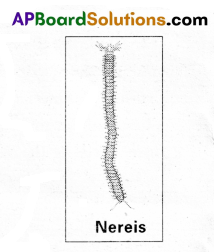
![]()
Quetsion 14.
Describe the structure of the heart of frog.
Answer:
The blood vascular system consists of the heart, blood vessels and blood. The heart is a muscular organ situated in the upper part of the body cavity. It has two separate atria and a single undivided ventricle. It is covered by a double layered membrane called peri – cardium. A triangular chamber called sinus venosus joins the right atrium on the dorsal side. It receives blood through three vena cavae (caval veins). The ventricle opens into the conus arteriosus on the ventral side. The conus arteriosus bifurcates into two branches and each of it divides into three aortic arches namely carotid, systemic and pulmocutaneous. Blood from the heart is distributed to all parts of the body by the branches of aortic arches. Three major veins collect blood from the different parts of the body and carry it to the sinus venosus.
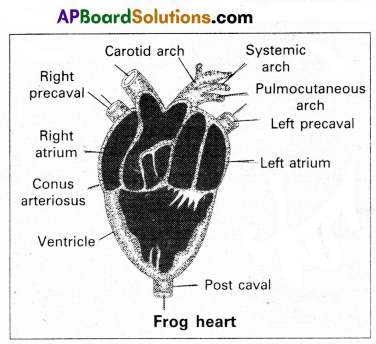
Question 15.
Describe the process of transverse binary fission in Paramecium.
Answer:
Transverse binary fission is performed by Paramecium. Binary fission is the most common method of a sexual reproduction in protozoans.
During favourable conditions, Paramecium stops feeding after attaining its maximum growth. At first the micronucleus divides by mitosis and the macronucleus divides into two daughter nuclei by amitosis. The oral groove disappears. After karyokinesis, a transverse constriction appears in the middle of the body, which deepens and divides the parent cell into two daughter individuals, the anterior proter and the posterior opisthe. The proter receives the anterior contractile vacuole, cytopharynx and cytosome from its parent individual. It develops posterior contractile vacuole and a new oral groove. The opisthe receives the posterior contractile vacuole of its parent.

It develops a new anterior contractile vacuole, cytopharynx, cytostome and a new oral groove. Binary fission is completed in almost two hours, in favourable conditions and Paramecium can produce four generations of daughter individuals by binary fission in a day.
The transverse binary fission is also called homothetogenic fission, because the plane of fission is at right angles to the longitudinal axis of the body. As it occurs at right angles to the kineties, it is also called perkinetal fission.
Question 16.
What is the need for parasites to develop special adaptations ? Mention some special adaptations developed by the parasites.
Answer:
Parasites have to evolve mechanisms to counteract and neutralize the host’s defence in order to be successful with in the host. For this purpose, the parasites have developed many special adaptations such as the loss of unnecessary sensory organs, formation of organs for adhesion, high reproductive capacity, etc.
Parasitic adaptations : Parasites have evolved special adaptations to meet the requirements and lead successful life in the hosts.
- In order to live in the host some parasites have developed structures like hooks, suckers, rostellum etc., for anchoring. e.g : Taenia solium.
- Some intestinal parasites have developed protective cuticle to with stand the action of the digestive enzymes of the host, e.g : Ascaris lumbricoides.
- Some intestinal parasites produce antienzymes to neutralize the effect of host’s digestive enzymes, e.g : Taenia solium.
- Some parasites live as obligatory anaerobes as the avail-ability of oxygen is very rare for them, e.g : Entamoeba histolytica, Taenia solium etc.
- Some intestinal parasites live as facultative anaerobes, i.e., if oxygen is not available, they live anaerobically and if oxygen is available, they respire aerobically, e.g : Ascaris lumbricoides.
![]()
Question 17.
Draw a neat labelled diagram of the mouthparts of cockroach.
Answer:
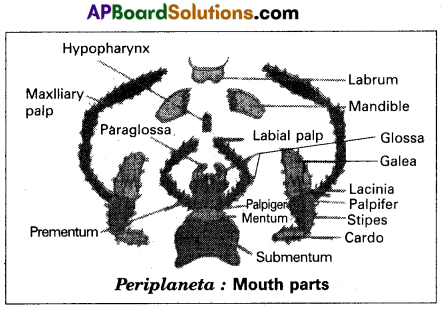
Question 18.
Define ecological pyramids and describe with examples pyramids of numbers and biomass.
Answer:
It is a graphical representation of the trophic structure and function of an ecosystem. The base of each pyramid represents the producers of the first trophic level, while the apex represents the tertiary or top level/top order consumers. The three types of ecological pyramids that are usually studied are (a) pyramid of number (b) pyramid ofbiamass and (c) pyramid of energy. These pyramids were first represented by Elton, hence the name ELTONIAN pyramids / Ecological pyramids.
Any calculations of energy content, biomass or numbers has to include all organisms at that trophic level. No generalizations we make will be true if we take only a few individuals of any trophic level into account. In most ecosystems, all the pyramids – of numbers, energy and biomass are uprights, i.e., producers are more in number and biomass than the herbivores, and herbivores are more in number and biomass than the carnivores. Also energy (available) at a lower trophic level is always more than that at a higher level.
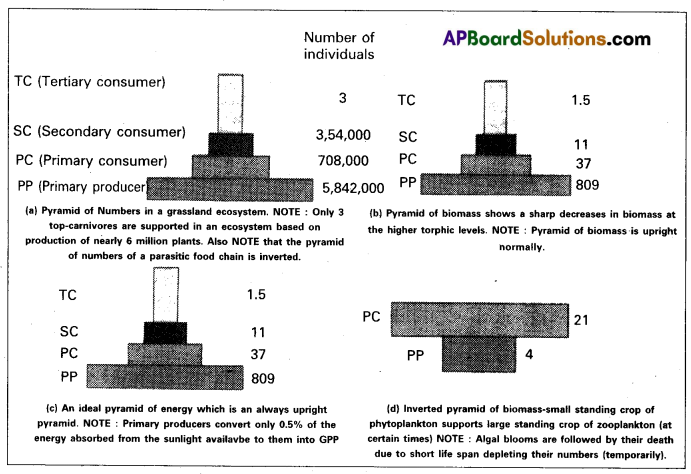
There are exceptions to this generalization. In the case of a parasitic food chain, the pyramid of numbers is inverted. A large tree (single producer) may support many herbivores like squirrels and fruit eating birds. On these herbivores many ectoparasites such as ticks, mites and lice (secondary consumers) may live. These secondary consumers may support many more top level consumers and also the hyper parasites. Thus in each trophic level from the bottom to the top, the numbers of organisms increase and form an ‘inverted pyramid’ of numbers.
The pyramid of biomass in sea is also generally inverted because the biomass of fishes far exceeds that of phytoplankton.
Section – C (2 × 8 = 16)
Note : Answer any two questions in 60 lines each.
Question 19.
Explain the structure and lifecycle of Entamoeba histolytica with the help of neat and labelled diagrams.
Answer:
Entamoeba histolytica (Gr. entos – within: amoiba – change histos – tissues ; lysis – dissolve) is a microscopic and monogenetic parasite that inhabits the large intestine and causes amoebic dysentery or amoebiasis in man.
It is cosmopolitan in distribution but more common in the tropical and subtropical regions of the world. It is common in the people of rural and densely populated urban areas wherever the hygienic conditions are poor.
Structure : Entamoeba histolytica passes through three distinct stages in its life cycle namely :
i) Trophozoite stage
ii) Precystic stage &
iii) Cystic stage.
i) Trophozoit stage : It is the most active, motile, feeding and pathogenic stage that lives in the mucosa and sub-mucosa membrane of the large intestine. It moves with the help of a lobopodium which is produced anteriorly. The body of the trophozoite is surrounded by plasma- lemma. Its cytoplasm is differentiated into outer clear, viscous non-granular ectoplasm and inner fluid like, granular endoplasm.
Ribosomes, food vacuoles and vesicular, cartwheel shaped nucleus are present in the endoplasm. The absence of mitochondria indicates the obligate anaerobic nature of Entamoeba histolytica. It produces the proteolytic enzyme called histolysin due to which the species name histolytica was assigned to it. Due to the effect of this enzyme the mucosa and sub-mucosa of the gut wall are dissolved releasing some amount of blood, tissue debris which are ingested by the trophozoites.
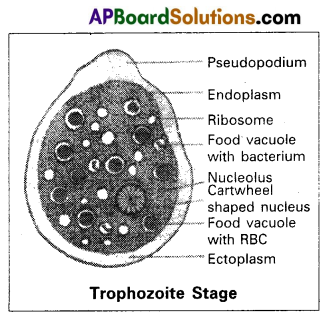
Hence the food vacuoles are with erythrocytes fragments of epithelial cells and bacteria. Presence of RBC in food vacuoles and cartwheel shaped nucleus are the characteristic features of the trophozoites of Entamoeba histlytica.
ii) Precystic stage : It is the non-feeding and non-pathogenic stage of Entamoeba histolytica that is found in the lumen of large intestine.
It is a small, spherical or oval, non-motile form. The cytoplasm of the precystic stage stores glycogen granules and chromotoid bars (made of ribonucleo protein) which act as reserve food.
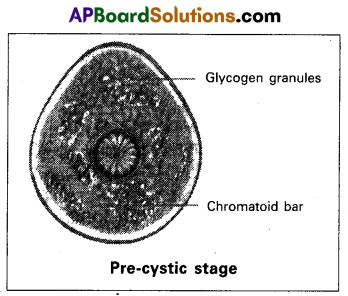
iii) Cystic stage : It is round in shape and is surrounded by a thin, delicate and highly resistant cyst wall. It is found in the lumen of the large intestine.
The process of development of cyst wall is called encystation. Which is a means of tide over the unfavourable conditions that the parasite is going to encounter while passing to a new host. Soon after the encystation, the nucleus undergoes two successive mitotic divisions to form four daughter nuclei. This type of cystic stage is called tetranucleate cyst or mature cyst which is the stage infective to man.
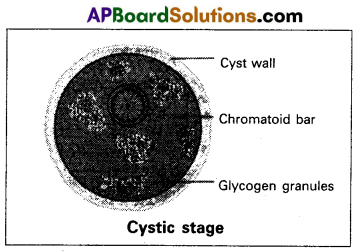
Life cycle : The trophozoites undergo binary fissions in the wall of the large intestine and produce a number of daughter entamoeba. They feed upon the bacteria and the host’s tissue elements, grow in size and again multiply. After repeated binary fission some of the young ones enter of the lumen of the large intestine and transform into precystic stages. Here, the precystic stages transform into cystic stages which in turn develop into tetranucleate cysts. The entire process is completed only in a few hours. These tetranucleate cysts come out along with the faecal matter and can remain alive for about 10 days. The cyst reach new host through contaiminated food and water. In the small intestine of a new human host the cyst wall gets reptured releasing the tetranucleate amoebae. Such tetranucleate excystic amoebae are called metacysts.

The four nuclei of the metacyst undergo mitotic divisions and produce eight nuclei. Each nucleus gets a bit of the cytoplasm and thus eight daughter entamoebae or metacystic trophozoites are produced. These young ones develop into feeding stages called trophozoites. They invade the mucous membrane of the large intestine and grow into mature trophozoites.
![]()
Question 20.
Describe the digestive system of cockroach with the help of a neat labelled diagram.
Answer:
The digestive system of cockroach consists of an alimentary canal and the associated glands. The preoral cavity surrounded by the mouth parts, is present infront of the mouth. The hypopharynx divides it into two chambers called cibagium (anterior) and salivarium (posterior).
Alimentary canal: The alimentary canal of cockroach is a long tube and is coiled at some places. It extends between the mouth and the anus. It is divided into three regions namely foregut of stomodaeum, midgut or mesenteron and hindgut are internally lined by ectoderm. The mesenteron is lined by the endodermal cells.
Forgut or stomodaeum: The foregut includes pharynx oesophagus, crop and gizzard. It is internally lined by a chitinous cuticle. Mouth opens into the pharynx, which in turn leads into a narrow tubular oesophagus. The oesophagus opens behind into a thin walled distensible sac called crop. The crop serves as a reservoir for storing food. Its outer surface is covered by a network of tracheae. Behind the crop there is a thick walled muscular proven-triculus or gizzard.
The chitinous inner living of the gizzard has six powerful teeth, which form an efficient grinding apparatus. Behind each tooth is a hairy pad, which bear?; backwardly directed bristles. Among these plates, food is through!} ground into fine particles. These food particles are filtered by the bristles. The gizzard thus acts both as a grinding mill and also as a sieve. There is a membranous projection of the gizzard into the me senteron in the form of a funnel called stomodeal valve. This valve prevents the entry (regurgitation) of food from the mesenteron back into the gizzard.
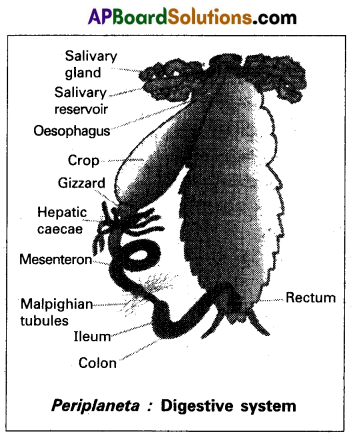
Midgut (mesenteron or ventriculus) : The midgut is a short and narrow tube behind the gizzard. It is also called mesenteron or ventriculus. Between the ventriculus and the gizzard, arising from ventriculus there are six to eighth finger like diverticule called hepatic caecae.
They are helpful in digestion and absorption of the digested food materials. Ventriculus is functionally divided into an anterior secretory part and a posterior absorptive part.
The secretory part of the ventriculus has many gland cells and it secretes several enzymes. The ‘bolus’ of food in the mesenteron is nveloped by a chitinous and porous membrane called peritrophic membrane, which is secreted by the funnel like stomodeal valve of the gizzard. Digested food is absorbed into the food through the peritrophic membrane in the posterior absorptive region of the ventriculus. The peritrophic membrane protects the wall of the ventriculus from hard food particles in the food. The opening of the ventriculus into the hindgut is controlled by a sphincture muscle. It prevents entry of undigested food from the hindgut into the midgut.
Hindgut or proctodaeum : The hindgut is a long coiled tube, consisting of three regions namely ileum, colon and rectum. It is interanlly lined by chitinous cuticle. The ileum that lies behind the mesenteron is a short tube. Six bundles of fine yellow, blind tubules called Malpighian tubules open into the ileum near the junction of mesenteron and ileum. Malpighian tubules are excretory in function. Ileum collects uric acid from the malpighian tubules and undigested food from the mesenteron. Ileum opens behind into a long coiled tube called colon. Colon leads into a short and wide rectum which opens out through the anus. Rectum bears on its inner side six longitudinal chitinous folds called rectal papillae. They are concerned with the reabsorption of water from the undigested food.
Digestive gland : The digestive glands associated with the alimentary canal of cockroach are salivary glands, hepatic caecae and glandular cells of the mesenteron.
Salivary glands : There is a pair of salivary glands attached to the vetrolateraf sides of the crop, one on each side. Each salivary gland has two lobes. Each lobe of salivary gland has many lobules called acini. Each acinus is a group of secretory cells called zymogen cells with a small ductule. The ductules of both the lobes of a salivary gland unite to form a common salivary duct on each side.

The two common salivary ducts are joined to form the median salivary duct. Between the two lobes of a salivary gland of each side is a sac called salivary receptacular duct or common reservoir duct. The midioiis salivary duct opens into the common receptacular duct. Later these two form an efferent salivaryduct. The efferent salivary duct opens at the base of the hypopharynx. Acinar cells secrete saliva, which contains starch digesting enzymes such as amylase.
Hepatic caecae : The hepatic caecae are also termed midguts caecae. They contain secretory and absorptive cells.
Glandular cells of the mesenteron : The glandular cells of the mesenteron secrete enzymes such as maltase, invertase, proteases and lipase.
![]()
Question 21.
Describe different types of food chains that exist in an ecosystem.
Answer:
The food energy passes from one trophic level to another trophic level mostly from the lower to higher trophic levels. When the path of food energy is ‘linear’ the components resemble the ‘links’ of a chain and it is called ‘food chain’. Generally a food chain ends with decomposers. The three major types of food chains in an ecosystem are Grazing Food Chain, Parasitic Food Chain and Detritus Food Chain.

i) Grazing food chain: It is also known as predatory food chain, it begins, with the green plants (producers) and the second third and fourth trophic levels are occupied by the herbivores, primary carnivores and secondary carnivores respectively. In some food chains these is yet another trophic level – the climax carnivores. The number of trophic levels in food chains varies form 3 to 5 generally. Some examples from grazing food chain (GFC) are given below.

ii) Parasitic food chain : Some authors included the Parasitic Food Chains as a part of the GFC. As in the case of GFCs, it also begins with the producers, the plants (directly or indirectly). However, the food energy passes from large organisms to small organisms in the parasitic chains. For instance, a tree which occupies the 1st trophic level provides shelter and food for many birds. These birds host many ectoparasites and endo parasites. Thus, unlike in the predator food chain, the path of the flow of energy includes fewer, large sized organisms in the lower trophic levels and numerous, small sized organisms in the successive higher trophic levels.
iii) Detritus Food Chain : The detritus food chain (DFC) begins with dead organic matter (such as leaf litter, bodies of dead organisms). It is made up of decomposers which-are heterotrophic organisms, mainly the ‘fungi’ and ‘bacteria’. They meet their energy and nutrient requirements by degrading dead organic matter or detritus. These are also known as saprotrophs (sapro : to decompose).
Decomposers : Secrete digestive enzymes that breakdown dead and waste materials (such as faeces) into simple absorbable substances. Some examples of detritus food chains are :
- Detritus (formed from leaf litter) – Earthworms – Frogs – Snakes.
- Dead animals – Flies and maggots – Frogs – Snakes.
In an aquatic ecosystem, GFC is the major ‘conduit’ for the energy flow. As against this in a terrestrial ecosystem, a much larger fraction of energy flows through the detritus food chain than through the GFC. Detritus food chain may be connected with the grazing food chain at some levels. Some of the organisms of DFC may form the prey of the GFC animals. For example, in the detritus food chain given above, the earthworms of the DFC may become the food of the birds of the GFC. It is to be understood that food chains are not isolated1 always.